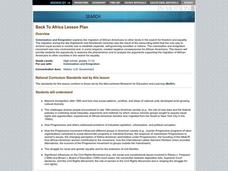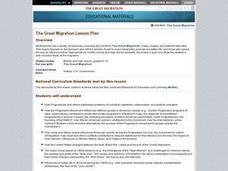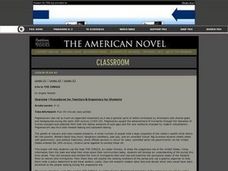Curated OER
Focused Learning Lesson: American History
Eleventh graders review the Progressive Movement and the Women's suffrage movement. They also review the changes from the end of World War I to the Great Depression.
Curated OER
Back To Africa
Students analyze the massive immigration after 1850 and how new social patterns, conflicts, and ideas of national unity developed amid growing cultural diversity, and how the Progressive movement influenced different groups in American...
Curated OER
Progressive Test Review
Students fill in the blank and matching worksheets relay-style. They are told that first team to complete the relay recieves five points on their exam. Students are explained that there are five phases of the game, and they are not...
Curated OER
Prohibition Then; MADD Today
Students examine consumer traits. For this economics lesson, students examine the separate histories of Prohibition and Mothers Against Drunk Driving. Students participate in a classroom simulation to discover how the movements dictated...
Curated OER
Gender-based Temperance Reform
Eleventh graders investigate the Temperance Reform Movement. In this primary source analysis instructional activity, 11th graders use the provided analysis sheet to analyze the contents of the article "Advice to Young Women and Young...
Curated OER
The Roots of Prohibition: Examining the Effort to Prohibit Alcohol in America
Five segements from Ken Burns' documentary series Prohibition, easily accessed on the PBS website, are at the center of a terrific short unit on the roots of America's ambivalent relationship with alcohol. Engage your secondary class...
Alabama Department of Archives and History
Voting Rights for Alabama Women
What were the arguments put forth by those who opposed the 19th Amendment? For those in favor? Class members examine primary source materials that illustrate the intense debate in Alabama about women's suffrage.
Curated OER
The Great Migration Lesson Plan
Students read a narrative "The Great Migration." They answer specific questions that check for understanding of the text. They discuss reasons for migrating. They choose an African-American hero/athlete to research online. They share...
Curated OER
The Volstead Act and Related Prohibition Documents
Students listen to the 18th Amendment. After a discussion on Prohibition, the groups determine if it was a success or a failure and present their findings to the class. They view political cartoons of the day and analyze their meaning.
Curated OER
Hatchet Job
Students explore the difference between temperance and prohibition. After reading a story, students explore the difference between a vigilante action and a protest. They explore social and political factors that may cause social...
City University of New York
Urban Politics: Machines and Reformers
What were political machines and whom did they serve? As part of a study of US immigration patterns and how these patterns influenced politics, groups investigate how Tammany Hall and other political machines gained support from voters.
Constitutional Rights Foundation
The Election of 1912
The Election of 1912: an election with four competitive opponents. Pupils get to know the candidates with informative reading passages that provide context to the election. Then, the class engages in a debate and answers questions as one...
Curated OER
Reporting on the 1920s
Use this roaring 1920s history lesson plan to have young writers research primary and secondary sources. They use their research to examine the events or famous public figures of the time period. Next, they imagine they're in the 1920s...
Curated OER
Life in THE JUNGLE
Students discuss problems immigrants may have when coming to a new country. They take on the role of a law maker from the era and create an action plan and policy based on samples they read (links provided). Students discuss ways their...
Curated OER
The AME Church in U.S. History
Ninth graders explore the history of the African Methodist Church in the United States. In this African American history lesson, 9th graders discover why the church was founded and research its history and noteworthy members. Students...
Curated OER
Woodrow Wilson
For this online interactive history worksheet, students respond to 10 short answer and essay questions about the achievements of Woodrow Wilson. Students may check some of their answers on the interactive worksheet.
Curated OER
Child Labor Laws in the United States and the State of Nebraska
Students examine child labor laws. In this social justice activity, students compare and contrast child labor laws of the United States and the state of Nebraska. Students research primary sources and complete the included analysis...
Curated OER
Child Labor Laws in America and Nebraska
Students research child labor laws in Nebraska and America. In this child labor lesson, students examine primary and secondary sources regarding legislation on child labor and create posters that highlight the laws of 1907 and 1910.
Curated OER
CIVIL DISOBEDIENCE
Students use events of the time to illustrate the significance of the 1965 Selma-to-Montgomery Voting Rights March.
Curated OER
History of American Child Labor
Students study the historical and social issue of child labor. They examine the photographs of Lewis Hine to see evidence of child labor and decide how the photographs depict the historical impact of the practice. They write a letter to...





















